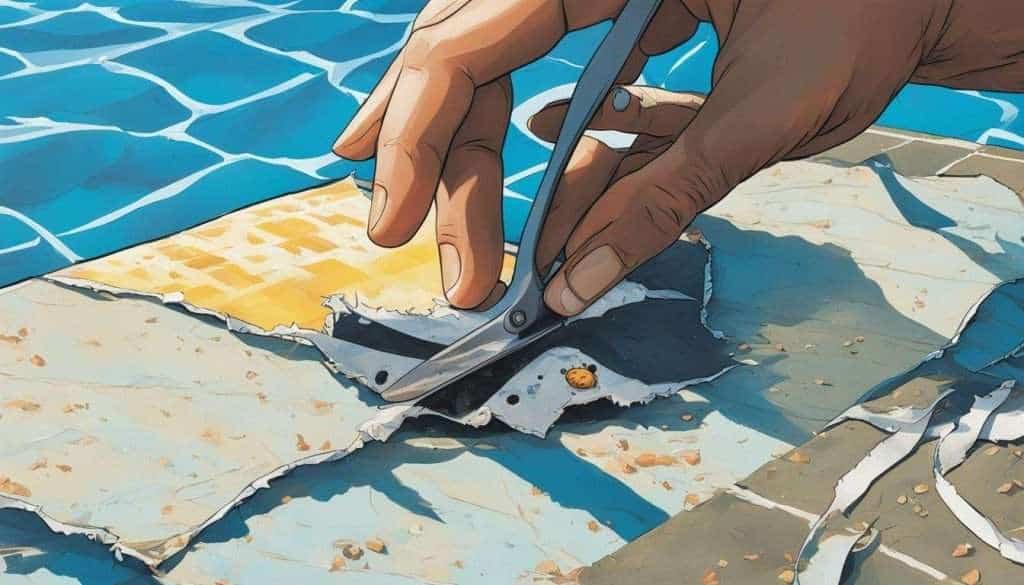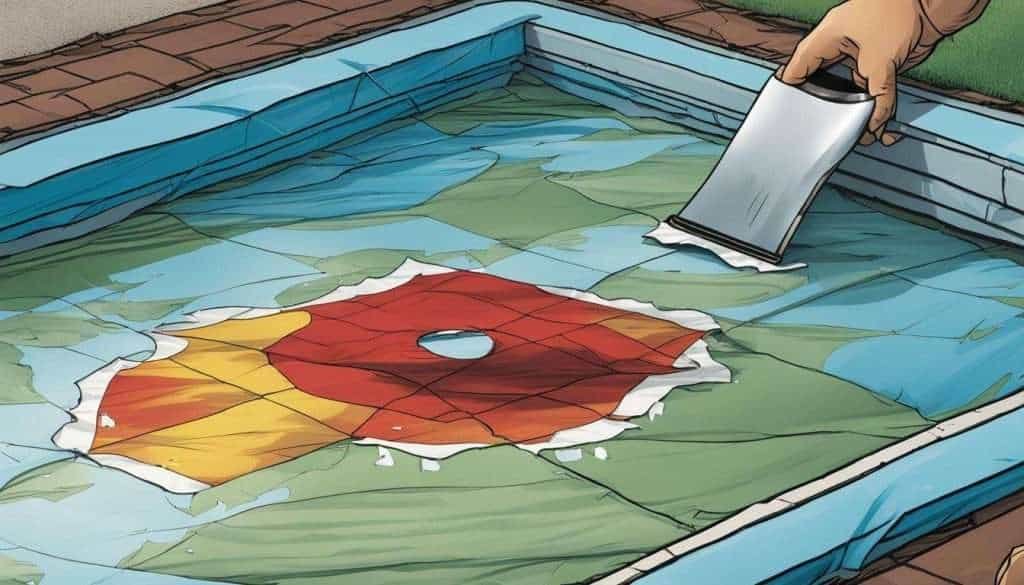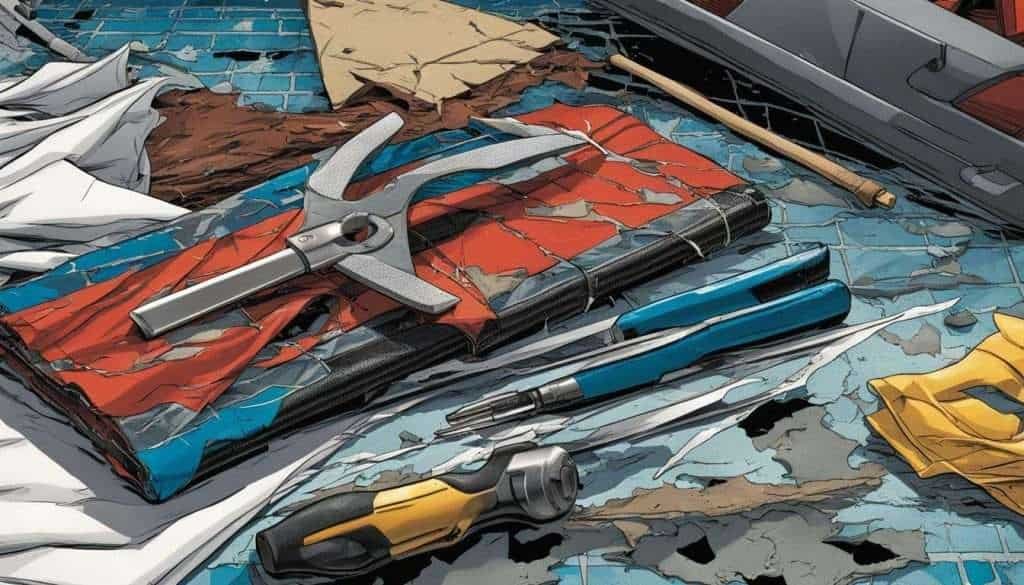When it comes to repairing a torn pool cover, it’s important to follow professional tips for effective and long-lasting results. Whether you have a small hole or a larger tear, there are specific techniques and considerations to keep in mind. In this section, we will provide you with expert advice on repairing your pool cover and ensuring its optimal performance.
- Inspect your pool cover regularly for any damage and address repairs promptly.
- Consider investing in a new cover if the damage is extensive or the cover is old.
- For smaller holes or tears, use a patch kit that matches your cover’s material type and color.
- Clean and dry the damaged area before applying the patch for better adhesion.
- For covers that require sewing, use a heavy-duty needle and industrial strength thread or fishing line.
- Consider replacing entire panels in safety covers through an industrial sewing service.
- Perform routine maintenance, such as removing debris and standing water, to prolong the life of the cover.
Factors to Consider Before Repairing a Torn Pool Cover
Assessing the condition of your torn pool cover and considering important factors can help you make an informed decision about the repair process. Before diving into the repair process, there are a few key factors to take into account.
Firstly, it’s important to evaluate the extent of the damage. If the tear is extensive or the cover is old and nearing the end of its lifespan, it may be more practical to invest in a new cover. Older covers are inherently more prone to tearing, particularly at stress points where they make contact with the pool’s edges.
For smaller holes or tears, less than 6 or 7 inches in length, you may be able to patch them up yourself. In such cases, a patch kit that matches the material type and color of your cover can be used. Before applying the patch, it’s crucial to clean and thoroughly dry the area. The patch should be cut to size with rounded corners to prevent lifting. Adhesive patches should be carefully pressed onto the cover, and for added durability, a matching patch can be applied to the other side.
Table 1: Recommended Patch Sizes
| Tear Size | Patch Size |
|---|---|
| Up to 2 inches | 3×3 inches |
| 2-4 inches | 6×6 inches |
| 4-6 inches | 8×8 inches |
If your pool cover requires sewing repairs, a heavy-duty needle with industrial strength thread or fishing line can be used. However, it’s worth noting that safety covers are generally more repairable than winter covers. In some cases, if the tear is extensive, it may be necessary to utilize the services of an industrial sewing provider who can replace entire panels. This ensures the integrity of the cover is maintained for continued protection.
Regularly inspecting your pool cover for any damage and addressing repairs promptly is crucial for preventing further tearing. Alongside repair considerations, routine maintenance is key to prolonging the life of your cover. This includes removing debris and standing water, checking the water level and reel components, and clearing off any mold that may accumulate. By following these guidelines and considering the important factors mentioned above, you can make informed decisions about the most effective repair approach for your torn pool cover.

For smaller holes or tears in your pool cover, you can use a patch kit and follow these step-by-step instructions to effectively repair the damage.
1. Begin by thoroughly cleaning and drying the area around the hole or tear. This will ensure proper adhesion of the patch.
2. Select a patch kit that matches the material type and color of your pool cover. This will help the repair blend in seamlessly.
3. Cut the patch to size, ensuring that it is slightly larger than the hole or tear. Rounded corners should be used to prevent the patch from lifting.
4. Apply adhesive to one side of the patch, then press it firmly onto the cover, covering the damaged area completely. Use a roller or your hand to remove any air bubbles and ensure a secure bond.
5. For added durability, consider applying a matching patch to the other side of the cover, following the same process. This will provide extra reinforcement and prevent further tearing.
Remember, proper patching can save your pool cover from further damage and extend its lifespan. By addressing small holes or tears promptly, you can ensure the optimal performance of your cover and enjoy a clean and well-maintained pool.
| Step | Instructions |
|---|---|
| 1 | Clean and dry the area around the hole or tear. |
| 2 | Select a patch kit that matches the material type and color of your pool cover. |
| 3 | Cut the patch to size, ensuring it is slightly larger than the hole or tear. |
| 4 | Apply adhesive to one side of the patch and press it firmly onto the cover, covering the damaged area completely. |
| 5 | Consider applying a matching patch to the other side of the cover for added reinforcement. |
Testimonial:
“I had a small tear in my pool cover and used a patch kit to fix it. The instructions were easy to follow, and the repair held up perfectly. I highly recommend this method for minor cover repairs.” – John, Pool Owner

For pool covers with larger tears or materials that don’t adhere well to adhesive patches, sewing repairs can provide a durable solution. When using a heavy-duty needle and industrial strength thread or fishing line, it’s important to choose a thread color that closely matches the cover to ensure a seamless repair. Begin by aligning the torn edges, holding them together with a strong pin or clip to keep them in place during sewing.
Take your needle and thread, and starting from the underside of the cover, push the needle through the fabric just outside the tear. Pull the thread through until it reaches the knotted end, leaving a small tail. Next, create a small stitch by inserting the needle back into the fabric near the tear and pulling the thread through to the underside. Repeat this process, spacing the stitches about 1/8 inch apart, until you reach the other end of the tear.
Once you’ve sewn the entire length of the tear, tie off the thread securely on the underside of the cover. To reinforce the repair, you can sew an additional row of stitches parallel to the first row, spacing them slightly closer together. This will provide extra strength and prevent the tear from expanding further. Remember to choose a thread color that matches the cover to ensure a seamless and discreet repair.
Expert Tip:
“When sewing a pool cover, it’s important to use a heavy-duty needle that won’t break or bend easily. Additionally, make sure to choose an industrial strength thread or fishing line that is durable and resistant to water and UV rays. This will ensure that your repair holds up well against the elements and prolongs the life of your cover.”
By following these sewing repair techniques, you can effectively fix larger tears in your pool cover. However, if the tear is extensive or beyond your sewing capabilities, it may be advisable to seek the services of an industrial sewing professional. They have the expertise and equipment to handle more complex repairs and ensure the longevity of your pool cover.

Repairing your pool cover depends on its type, and in this section, we’ll explore the specific repair methods for safety covers and winter covers. Safety covers are generally more repairable than winter covers, and they offer more flexibility when it comes to fixing tears or damages.
For safety covers, small holes or tears can be patched using a patch kit that matches the cover’s material. Before applying the patch, make sure to clean and dry the area thoroughly. Cut the patch to size with rounded corners to prevent lifting, and press it onto the cover. For added durability, you can apply a matching patch to the other side. If the tear is larger or the material is not suitable for adhesive patches, sewing repairs may be necessary. Use a heavy-duty needle with industrial strength thread or fishing line to sew the torn area. In some cases, if the damage is extensive, it may be more practical to replace entire panels. An industrial sewing service can assist with these more extensive repairs.
Winter covers, on the other hand, are typically more challenging to repair. Due to their construction and material, patching may not be as effective. However, small holes or tears can still be addressed using adhesive patches similar to those used for safety covers. If the damage is significant, it may be necessary to consider replacing the winter cover altogether. Regular inspection and maintenance are crucial in preventing extensive damage to winter covers, and promptly addressing repairs can help prolong their lifespan.
| Type of Pool Cover | Repair Methods |
|---|---|
| Safety Cover | – Patch small holes or tears with a matching patch kit – Sew larger tears with a heavy-duty needle and industrial strength thread – Replace entire panels if necessary |
| Winter Cover | – Patch small holes or tears with adhesive patches – Consider replacing the cover for significant damage |
Regularly inspecting your pool cover for any damage and promptly addressing repairs is essential. By taking care of your pool cover and performing routine maintenance tasks, such as removing debris and standing water, checking water levels and reel components, and clearing off any mold, you can help prolong its life and ensure optimal performance.

By following the repair tips and maintenance suggestions outlined in this guide, you can effectively repair a torn pool cover and maintain its durability and functionality for years to come. When it comes to repairing a torn pool cover, it is important to follow the recommended steps to ensure a proper fix. In addition, regularly maintaining the pool cover, such as cleaning and inspecting it for any potential issues, can help prevent future tears and damage. By taking these measures, you can extend the lifespan of your pool cover and avoid the need for costly replacements. For a full pool cover cost breakdown, including repair and maintenance expenses, consult with a professional to assess the overall investment required for keeping your pool cover in top condition.
When it comes to repairing a torn pool cover, it’s important to assess the extent of the damage and consider the age of the cover. If the damage is extensive or the cover is nearing the end of its lifespan, it may be more practical to invest in a new cover. Older covers are more susceptible to tearing, particularly at stress points where they come into contact with the pool’s edges.
For smaller holes or tears, less than 6 or 7 inches in length, a patch kit that matches the material and color of the cover can be used. Before applying the patch, it is crucial to clean and dry the area thoroughly. The patch should be cut to the appropriate size with rounded corners to prevent lifting. Adhesive patches can be pressed onto the cover, and for added durability, a matching patch can be applied to the other side.
Some pool covers may require sewing repairs, especially if the tear is larger or the material is not suitable for adhesive patches. Using a heavy-duty needle and industrial strength thread or fishing line, it is possible to sew the torn area together. Safety covers are generally more repairable than winter covers, and in certain cases, an industrial sewing service can replace entire panels.
In addition to addressing repairs promptly, regularly inspecting your pool cover for any damage is crucial in preventing further tearing. Routine maintenance, such as removing debris and standing water, checking water levels and reel components, and clearing off any mold, can help prolong the life of your pool cover and ensure its optimal performance.
Can I Repair a Torn Pool Cover Myself Using Professional Tips?
Repairing pool covers can be a daunting task for many, but with professional tips, it is possible to fix a torn pool cover yourself. From patch kits to adhesive products specifically designed for pool covers, there are various options to mend the damage. However, it’s crucial to assess the severity of the tear before attempting any repairs, and seek expert guidance if needed.
FAQ
Q: When should I consider investing in a new pool cover?
A: If the damage to your pool cover is extensive or the cover is old and nearing the end of its lifespan, it may be better to replace it with a new cover. Older covers are more prone to tearing, especially at stress points where they touch the pool’s edges.
Q: How do I patch small holes or tears in my pool cover?
A: For smaller holes or tears, less than 6 or 7 inches in length, you can use a patch kit that matches the cover’s material type and color. Before applying the patch, make sure to clean and dry the area thoroughly. Cut the patch to size with rounded corners to prevent lifting. Adhesive patches should be pressed onto the cover, and a matching patch can be applied to the other side for added durability.
Q: Can I sew repairs on my pool cover?
A: Yes, some pool covers may require sewing repairs, especially if the tear is larger or the material is not suitable for adhesive patches. You can use a heavy-duty needle with industrial strength thread or fishing line to sew the torn area. However, for more extensive repairs, it may be necessary to utilize an industrial sewing service.
Q: How do I repair different types of pool covers?
A: Different types of pool covers require specific repair approaches. Safety covers are generally more repairable than winter covers. For safety covers, you may have the option of replacing entire panels with the help of an industrial sewing service. Winter covers may be patched or sewn depending on the extent of the damage and the cover’s material.
Q: How can I maintain my pool cover to prevent further damage?
A: Regularly inspect your pool cover for any damage and address repairs promptly to prevent further tearing. It’s important to remove debris and standing water, check water levels and reel components, and clear off any mold. Routine maintenance will help prolong the life of your pool cover and ensure its optimal performance.


